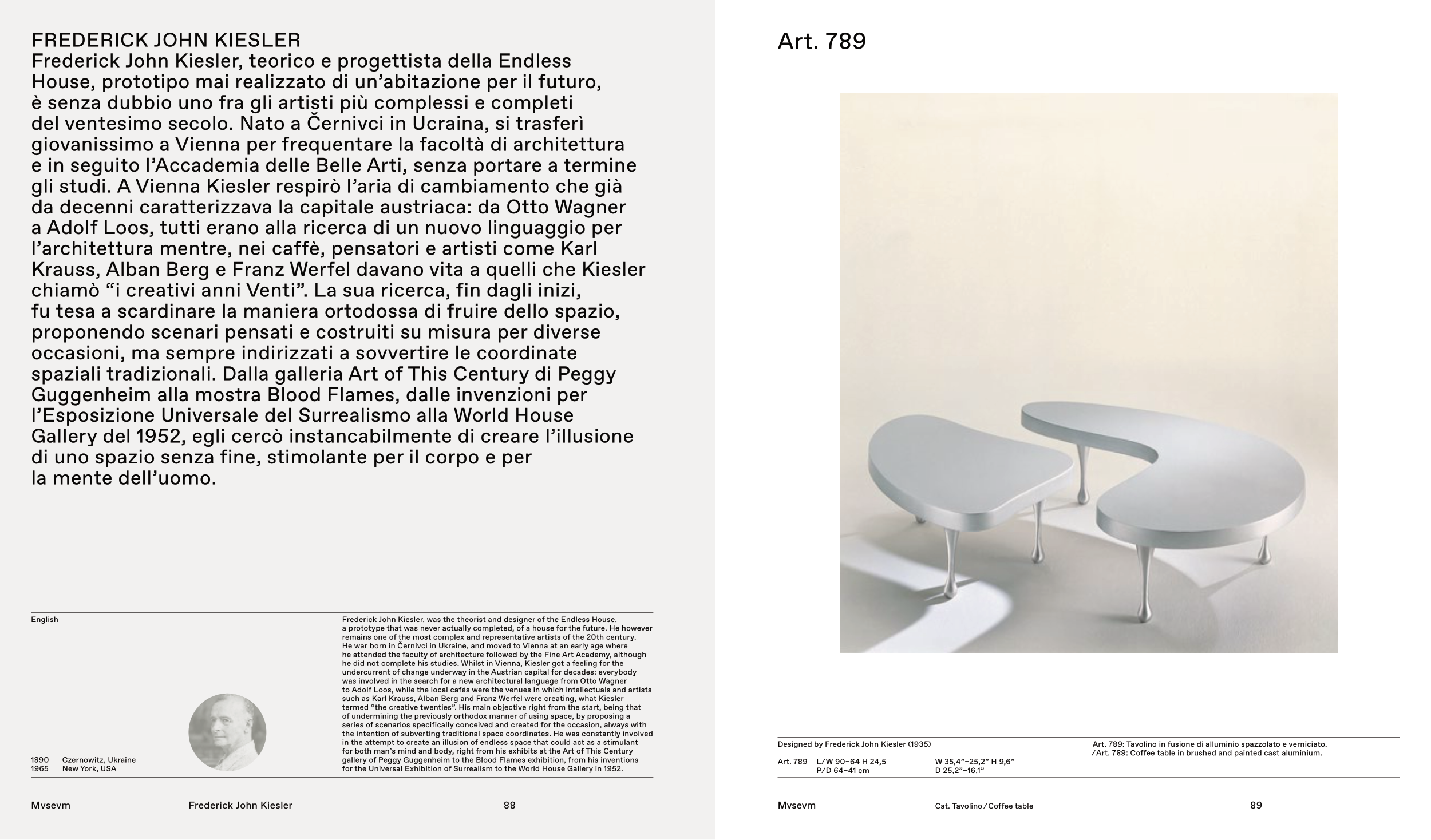88
89
Art. 789
Designed by Frederick John Kiesler (1935)
Art. 789
L ⁄ W 90–64 H 24,5
P ⁄ D 64–41 cm
W 35,4”–25,2” H 9,6”
D 25,2”–16,1”
Art. 789: Tavolino in fusione di alluminio spazzolato e verniciato.
⁄ Art. 789: Coffee table in brushed and painted cast aluminium.
Mvsevm
Cat. Tavolino ⁄ Coffee table
Mvsevm
Frederick John Kiesler
Frederick John Kiesler, was the theorist and designer of the Endless House,
a prototype that was never actually completed, of a house for the future. He however
remains one of the most complex and representative artists of the 20th century.
He war born in Černivci in Ukraine, and moved to Vienna at an early age where
he attended the faculty of architecture followed by the Fine Art Academy, although
he did not complete his studies. Whilst in Vienna, Kiesler got a feeling for the
undercurrent of change underway in the Austrian capital for decades: everybody
was involved in the search for a new architectural language from Otto Wagner
to Adolf Loos, while the local cafés were the venues in which intellectuals and artists
such as Karl Krauss, Alban Berg and Franz Werfel were creating, what Kiesler
termed “the creative twenties”. His main objective right from the start, being that
of undermining the previously orthodox manner of using space, by proposing a
series of scenarios specifically conceived and created for the occasion, always with
the intention of subverting traditional space coordinates. He was constantly involved
in the attempt to create an illusion of endless space that could act as a stimulant
for both man’s mind and body, right from his exhibits at the Art of This Century
gallery of Peggy Guggenheim to the Blood Flames exhibition, from his inventions
for the Universal Exhibition of Surrealism to the World House Gallery in 1952.
1890
Czernowitz, Ukraine
1965
New York, USA
English
FREDERICK JOHN KIESLER
Frederick John Kiesler, teorico e progettista della Endless
House, prototipo mai realizzato di un’abitazione per il futuro,
è senza dubbio uno fra gli artisti più complessi e completi
del ventesimo secolo. Nato a Černivci in Ucraina, si trasferì
giovanissimo a Vienna per frequentare la facoltà di architettura
e in seguito l’Accademia delle Belle Arti, senza portare a termine
gli studi. A Vienna Kiesler respirò l’aria di cambiamento che già
da decenni caratterizzava la capitale austriaca: da Otto Wagner
a Adolf Loos, tutti erano alla ricerca di un nuovo linguaggio per
l’architettura mentre, nei caffè, pensatori e artisti come Karl
Krauss, Alban Berg e Franz Werfel davano vita a quelli che Kiesler
chiamò “i creativi anni Venti”. La sua ricerca, fin dagli inizi,
fu tesa a scardinare la maniera ortodossa di fruire dello spazio,
proponendo scenari pensati e costruiti su misura per diverse
occasioni, ma sempre indirizzati a sovvertire le coordinate
spaziali tradizionali. Dalla galleria Art of This Century di Peggy
Guggenheim alla mostra Blood Flames, dalle invenzioni per
l’Esposizione Universale del Surrealismo alla World House
Gallery del 1952, egli cercò instancabilmente di creare l’illusione
di uno spazio senza fine, stimolante per il corpo e per
la mente dell’uomo.


